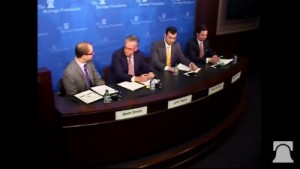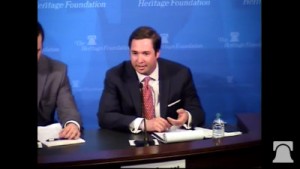
Heritage Foundation panel on FAA drone regulations. From left to right: Jason Snead; John Taylor; Marc Scribner; Michael Sargent.
The regulatory atmosphere surrounding unmanned aerial vehicles (UAVs), also known as drones, has been pockmarked with uncertainty in recent months. After grabbing a good deal of press at 2015’s Consumer Electronics Show, the popularity of drones has been checked over public safety concerns which have led towards a propensity for strict regulation, especially where the Federal Aviation Administration (FAA) is concerned. Last February, the FAA issued a proposed framework of regulations for drones, defining rules of operation for UAVs weighing less than 55 pounds. At a Senate hearing on drones last March, calls came from multiple industries to loosen rules on line-of-sight operation and other regulations constraining commercial and industrial use.
In December, the FAA announced that it would be creating a Small Unmanned Aircraft System (UAS) registry for owners of drones weighing between 0.55 pounds and 55 pounds. As of February 19th of this year, FAA rules went into effect which would put any drone operator not on the agency’s UAS registry on the hook for up to $27,500 in civil penalties, as well as criminal penalties of a fine up to $250,000 and a potential three years in prison. Steep, yes, but when the safety of human lives is on the table, money tends to be no object.
There is a legitimate question to be raised, however, over whether the FAA’s registry regulations and the harsh penalties for offenders actually makes our skies any safer for American citizens. That was a question tackled by a panel at The Heritage Foundation at a moderated discussion on better approaches to U.S. drone policy held on the afternoon of Thursday, April 28th. The day’s conversation touched on topics of FAA preemption of local and state authorities and other legal developments in the realm of UAVs.
Marc Scribner, a research fellow from the Competitive Enterprise Institute, remarked that there was a great deal of uncertainty and ambiguity in FAA’s regulatory authority. “The statutory definition of aircraft is so broad that it could presumably include frisbees,” Scribner said, noting that the FAA typically claims jurisdiction over any flying object, regardless of how low to the ground it may be flying. Even though the FAA recently updated a 30-year old guidance document on model aircraft, Scribner finds many of the FAA practices regarding UAVs so overly broad that conflicting approaches result. “We’re relying on what the FAA has pop into its head that day,” Scribner said. He would continue to say that Congress definitely had a role to step in and try to rein in the authority of the FAA on this issue.
If a legislative solution to vagaries in FAA drone regulations aren’t presented, a judicial branch assessment of the agency’s ruling can be expected as a result of a lawsuit filed by John Taylor, a Maryland attorney and a drone hobbyist. News that a million drones would be purchased during the 2015 holiday season and the subsequent FAA drone registry provided Taylor with a small window of opportunity to legally challenge the process of registering a million American drone owners. Pulling out a tiny drone fitting easily in the palm of his hand, Taylor noted that because this small drone was too lightweight for the drone registry, the rules require that it now be registered under Part 47 requirements. “They’re trying to take a process designed for real aircraft and shoehorning in these toys,” Taylor said.
The narrative was that the FAA was overstepping its regulatory boundaries in how it was addressing drones, especially in light of aspects of the FAA Modernization and Reform Act of 2012, the most recent FAA reauthorization bill signed into U.S. federal law. Section 336 of that law says that the FAA may not promulgate any rule or regulation regarding a model aircraft if that model aircraft meets a series of stipulations: the craft is flown strictly for hobby or recreational use; the craft is operated in accordance with a community-based set of safety guidelines within the programming of a national community-based organization; the craft weighs less than 55 pounds; the craft doesn’t interfere with and gives way to manned aircraft; and the owner provides notice to air traffic control when operating model aircraft within five miles of an airport. The recent registry set up by the FAA skirts Section 336, however, as it’s a rule affecting model aircraft (the FAA’s own press release on this registry even states that “model aircraft” must be registered if used for hobby or recreational purposes, so it seems clear that somewhere along the line, Section 336 was pretty heavily disregarded).
As Michael Sargent, research associate at the Heritage Foundation, points out, the fact that all UAVs are defined as aircraft gets the federal government involved in many aspects of drone operation in a heavy-handed way. “If there’s a drone over the backyard and a child hits it with a baseball, we’re talking a federal crime like someone crashed a passenger aircraft,” Sargent said. He also agreed that clearing up this regulatory picture would require work between Congress and the FAA. The FAA’s registry has also served to criminalize previously innocuous drone activity. As the day’s moderator, policy analyst Jason Snead, pointed out, if the FAA’s numbers are to be believed and only 330,000 drone owners out of one million have registered their drones, “they’ve just made 700,000 felons out of hobbyists.”
The way that the FAA uses Section 333 of the 2012 reauthorization act was also up for scrutiny during the panel discussion. Section 333 regards special rules regarding exemptions for certain types of drone operations that can be allowed before the full integration of civil UAS into the national airspace as required by Section 332 of the law. Though the Section 333 waiver has been used to grant exemptions for some commercial development of UAVs, it might be using this power in a way that lifts FAA’s regulatory powers above Congressional legislation, especially the longer that it takes to fully implement Section 332. “[The FAA] can go back and say, ‘We never actually completed Congress’s requirement,’ and kick the can down the road indefinitely while tricking people into thinking that they actually did complete the statutory required rulemaking,” Scribner said. He would also go on to compare what he saw as the FAA’s twisting of administrative law to a “shell game.”
As to the idea that the FAA’s drone registry actually accomplishes positive results for public safety, the panelists seemed to doubt that. Scribner hypothesized that the impetus for the FAA’s registry could have just as easily come from FAA staff who saw a headline about the million drones sold at Christmas and felt that agency response was required for no actual public safety concern. “The registry itself does not mitigate any safety risk,” Scribner added, noting that the way FAA was having drone operators register and place registration numbers anywhere on a drone, even concealed within the battery pack, would do little to help track down an owner in the event that the drone caused issues with manned aircraft, which could easily pulverize a UAV. “There’s a perception that ‘We had to do something about this issue,’ so they did something,” Taylor said, further calling the registry a “feel good measure.” “Hundreds of thousands of people who will never fly recklessly signed up and gave information and it’s not going to accomplish anything,” he said.
Some panelists questioned why there was a need to single out UAVs as a particularly dangerous threat to manned aircraft when it was clear that there were far greater environmental risks to aircraft. Sargent chastised the media, saying that they have “not been much of a help on this” by overstating drone risks, further noting that damage risks from large birds were far greater than drones. He also cited statistics published by Popular Science which found that, while there were no collisions between UAVs and manned aircraft between 1990 and 2015, there were 200 collisions between aircraft and turtles during that same time period and yet there is no turtle registry. Taylor expanded the scope of this idea, mentioning that while a few dozen people died in recreational watercraft accidents each year, and hundreds are put into hospitals from injuries related to all-terrain vehicles (ATVs), he was not aware of any story where an American was injured by a drone. At this moment, we have to point out a story we’ve reported on in previous drone coverage which the New York Post reported in September 2013 involving a 19-year-old drone operator that was decapitated by his own drone in a Brooklyn park, but Taylor’s point that news of horrific drone accidents are few and far between seems reasonable despite this case.
Media hysteria over improperly perceived threats from drones could in turn be impacting how often aircraft pilots think that they’ve witnessed a drone. Recent hysteria that a UAV may have contacted a recent British Airlines flight landing at London’s Heathrow Airport may have been completely unfounded as it’s speculated that the object could have been a plastic bag, a story which Taylor cited. In a similar story, Taylor brought up news reports from last February featuring a story about a pilot landing at Boston’s Logan International Airport who spotted a drone. Although the news headlines clearly state that the pilot saw a drone, transcripts from the pilot indicate that it could have been a drone or a balloon. “I can see why the FAA is concerned about it,” Sargent said, “but at the same time it’s a new technology and people rush to regulation and media coverage and try to impose ridiculous new standards because the technology is intriguing and brand new.”
Members of the day’s panel also had little hope for the latest FAA reauthorization bill, recently passed by a 95-3 vote in the U.S. Senate which has now passed it to the floor of the U.S. House of Representatives. Sargent took exception to three major issues which he saw with the legislation, namely that new manufacturing requirements allowed the FAA to micromanage many aspects of the drone manufacturing process, leaving an unresolved issue for homemade drones on the question of whether they can participate in the national airspace. Sargent said he “rolled his eyes” at a requirement that drone operators pass an online test administered by the FAA pertaining to UAS rules and regulations. Of great importance to Sargent was the fact that the Senate bill gives the FAA some preemptive powers over state and local governments on regulating UAS operations. “A local school district wouldn’t be able to prohibit drone usage from right outside of its walls during school hours,” Sargent said, adding that there should be some balance between federal and local governments.
“The Senate bill is horrible, I don’t like it at all,” Scribner said, arguing that it was especially harmful to hobbyists and entrepreneurs who can’t afford the legal costs of regulation compliance the way that large commercial interests can. “If you don’t have entrepreneurs, you won’t have future innovations,” Scribner said. As to local and state preemption, Scribner did say that he has seen awful local ordinances and state regulations criminalizing what is essentially innocuous behavior.

![[IPWatchdog Logo]](https://ipwatchdog.com/wp-content/themes/IPWatchdog%20-%202023/assets/images/temp/logo-small@2x.png)




![[Advertisement]](https://ipwatchdog.com/wp-content/uploads/2024/04/UnitedLex-May-2-2024-sidebar-700x500-1.jpg)
![[Advertisement]](https://ipwatchdog.com/wp-content/uploads/2024/04/Artificial-Intelligence-2024-REPLAY-sidebar-700x500-corrected.jpg)
![[Advertisement]](https://ipwatchdog.com/wp-content/uploads/2024/04/Patent-Litigation-Masters-2024-sidebar-700x500-1.jpg)

![[Advertisement]](https://ipwatchdog.com/wp-content/uploads/2021/12/WEBINAR-336-x-280-px.png)
![[Advertisement]](https://ipwatchdog.com/wp-content/uploads/2021/12/2021-Patent-Practice-on-Demand-recorded-Feb-2021-336-x-280.jpg)
![[Advertisement]](https://ipwatchdog.com/wp-content/uploads/2021/12/Ad-4-The-Invent-Patent-System™.png)






Join the Discussion
One comment so far.
John Taylor
May 24, 2016 01:38 pmExcellent coverage. Just to clarify, the young man mentioned in the article, who was killed, was flying a large nitro gas-powered helicopter, not a drone. There have been minor injuries involving drones, but I do not believe any American has yet been seriously injured by a hobby drone. I’m sure that will eventually occur, but it’s a pretty impressive safety record to date. Thanks again.